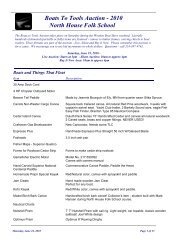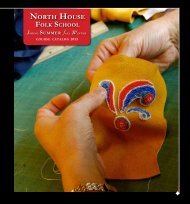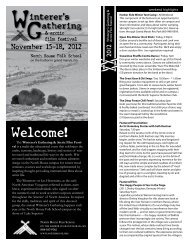2013 Event Program (PDF) - North House Folk School
2013 Event Program (PDF) - North House Folk School
2013 Event Program (PDF) - North House Folk School
You also want an ePaper? Increase the reach of your titles
YUMPU automatically turns print PDFs into web optimized ePapers that Google loves.
Natural Plant Dyes: Tutorial for Weavers with Karen Rognsvoog<br />
2/15 | <strong>North</strong> <strong>House</strong> <strong>Folk</strong> <strong>School</strong><br />
No matter your weaving skill level, choosing materials is always an<br />
exciting part of starting a new project. In this workshop you’ll learn to<br />
use plants to dye fibers and materials for weaving projects. We’ll cover<br />
mordants, how to grow your own dye plants, gathering in the wild,<br />
and the best way to store plant materials. We will dye some novelty<br />
yarns (bamboo, mohair, flax, soy, and silk) and unconventional materials<br />
(raffia, pina cloth, ribbon, feathers, etc.) for use in weft-face projects<br />
and embellishment. Take home a bundle of inspiring materials!<br />
Ceinture Fléchée: Beginning Fingerweaving with Marie Westerman<br />
2/15 | <strong>North</strong> <strong>House</strong> <strong>Folk</strong> <strong>School</strong><br />
Ceinture Fléchée was the intricate technique used in the Canadian<br />
interior to create the famous and colorful sashes worn by the voyageurs<br />
during the fur trade period. This course will introduce the basic<br />
finger weaving technique used to create those distinctive sashes. Each<br />
student will weave a two-color narrow strap using the chevron pattern,<br />
the most basic traditional patter. During the course, the instructor will<br />
demonstrate some of the more advanced patterns. Students will have<br />
the opportunity to explore a more complex four-color chevron if they<br />
wish, or they may spend time completing the initial project.<br />
Sculptural Knitting with Karen Searle<br />
2/16 | Grand Marais Art Colony<br />
We will explore uncharted knitting territory, using circular and diagonal<br />
knitting to create sculptures, vessels, and/or jewelry. We will work<br />
with yarns and non-traditional materials to design and shape 3-dimensional<br />
forms. Individual help with project design will be given. Examples<br />
of work by artists who use knitting as an expressive medium will<br />
inspire further explorations. This class can be taken individually or<br />
with Sculptural Crochet on February 17.<br />
Knitting Socks: The Essential Craft with Kate Hartman<br />
2/16 | <strong>North</strong> <strong>House</strong> <strong>Folk</strong> <strong>School</strong><br />
Why not knit your own socks? After all, “you can’t go barefoot,” as<br />
your mom used to say. In this day-long introduction to knitting socks,<br />
you’ll be on your way to making your own socks for the rest of your<br />
life. Learn the skills to make socks including reading knitting<br />
patterns, circular knitting on double point needles, shaping<br />
the heel and shaping and closing the toe. You start on<br />
a model sock and are encouraged to bring a sock<br />
pattern you would like to make in<br />
the future. The instructor will guide<br />
you through the instructions.<br />
Button it Up! with Nancy Seaton<br />
2/16 | Grand Marais Art Colony<br />
Finish your new sweater with your own fused glass<br />
buttons! In this half day class, students will make<br />
12 original one inch buttons while learning the basics<br />
of fused glass. Each button will be an original design<br />
featuring a collage of colors, shapes and textures. Buttons<br />
can be picked up on Sunday morning.<br />
Spinning Fibers on a Wheel with Alan Holzhueter<br />
2/16-17 | <strong>North</strong> <strong>House</strong> <strong>Folk</strong> <strong>School</strong><br />
The classic Saxony-style spinning wheel is still a symbol of the “olden<br />
days.” Although the spinning wheel is no longer a household necessity<br />
for producing a family’s clothing, many find great satisfaction in<br />
spinning their own yarns. In this two-day introductory spinning class,<br />
you will be introduced to fibers suitable for spinning, fiber preparation<br />
and spinning prepared fiber on a spinning wheel. Participants are<br />
encouraged to bring their own working spinning wheel. The instructor<br />
will have three wheels available for students to share.<br />
Felting a Seamless Wool Vest with Elise Kyllo<br />
2/16-17 | <strong>North</strong> <strong>House</strong> <strong>Folk</strong> <strong>School</strong><br />
Using the wet felting process of wool, soap, water and agitation, woolen<br />
fibers can be transformed into a durable, beautiful and warm vest.<br />
Using wool batting, roving and yarns we will use the resist technique<br />
to create a very large pocket which you will wet felt to form a vest to<br />
fit you or someone you love. Some felting experience is helpful. Come<br />
with a sense of adventure and willingness to agitate the wool until it<br />
shrinks to fit you!<br />
Beginning Millinery & Haberdashery:<br />
The Blocked Felt Hat with Emily Moe<br />
2/16-17 | <strong>North</strong> <strong>House</strong> <strong>Folk</strong> <strong>School</strong><br />
Minnesota’s history is interwoven with the history<br />
of hat-making. Europe’s hunger for beaver<br />
felt top hats drove the voyageurs into the<br />
heart of fur country. Most of the fur traded at<br />
Grand Portage eventually became felt hats. There<br />
is no softer, warmer or more pliant fiber as fur-felt.<br />
We will use millinery fur-felt hat blanks to create hats<br />
using the same methods used by milliners since the<br />
1300s (minus the infamous mercury), but our creations<br />
will reflect the character and personality of each student.<br />
The student will use mysterious and magical sounding<br />
materials -- melousine, ferrule, puzzle blocks and petersham -- to<br />
make a couture quality felt hat entirely by hand. Some sewing experience<br />
is helpful but not necessary.








